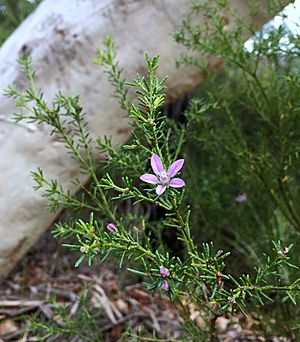Philotheca salsolifolia facts for kids
Philotheca salsolifolia is a type of flowering plant that belongs to the Rutaceae family. It is a shrub that grows only in New South Wales and the Australian Capital Territory in Australia. This plant has many leaves that are usually round or cylindrical. Its flowers are pink to mauve, often with a dark stripe in the middle. They usually grow alone or in small groups at the ends of the branches.
Quick facts for kids Philotheca salsolifolia |
|
|---|---|
 |
|
| In Muogamarra Nature Reserve | |
| Scientific classification | |
| Genus: |
Philotheca
|
| Species: |
salsolifolia
|
| Synonyms | |
|
|
What it Looks Like
Philotheca salsolifolia is a shrub that can grow up to 2 m (6 ft 7 in) (about 6.5 feet) tall. Its branches are mostly smooth, meaning they don't have hairs.
The leaves grow very close together. They are thick and can be cylindrical, about 3–5 mm (0.12–0.20 in) long. Some leaves are narrow and pointed, growing up to 12 mm (0.47 in) long.
The flowers appear alone or in groups of two or three at the tips of the branches. Each flower sits on a small stalk called a pedicel. These pedicels can be short and top-shaped (1–2 mm (0.039–0.079 in) long) or thin and longer (about 8 mm (0.31 in) long).
Each flower has five sepals, which are small, triangular parts at the base of the flower, about 1.5 mm (0.059 in) long. It also has five petals that are narrow and oval-shaped, 6–12 mm (0.24–0.47 in) long. These petals are pink to mauve and often have a dark stripe down the middle.
Inside the flower, there are ten stamens. These are the parts that produce pollen. They are smooth and joined together at their bottom half, but they are very hairy above. This plant usually flowers from September to December. After flowering, it produces a fruit that is 5–6 mm (0.20–0.24 in) long and has a pointed tip.
How it Got its Name
This plant was first officially described in 1809 by a scientist named James Edward Smith. He gave it the name Eriostemon salsolifolius. This description was published in a large book called The Cyclopaedia.
Later, in 1917, another scientist named George Claridge Druce changed its name to Philotheca salsolifolia. This new name is the one we use today.
In 1998, a scientist named Paul Wilson found that there are two slightly different types of this plant, which he called subspecies. These subspecies are recognized by the Australian Plant Census, which keeps track of all Australian plants.
- Philotheca salsolifolia subsp. pedicellata: This type has thin pedicels (flower stalks) that are 6–9 mm (0.24–0.35 in) long. Its leaves are longer, about 8–15 mm (0.31–0.59 in) long.
- Philotheca salsolifolia subsp. salsolifolia: This type has shorter, top-shaped pedicels, only 1–2 mm (0.039–0.079 in) long. Its leaves are also shorter, about 3–5 mm (0.12–0.20 in) long.
Where it Grows
Philotheca salsolifolia likes to grow in areas with heathlands, which are open areas with small shrubs. It can be found in rocky or sandy places within forests and woodlands.
This plant is common across New South Wales and the Australian Capital Territory. You can find it from places like Yamba in the north, down to Bega on the south coast. It also grows inland as far as West Wyalong and the Pilliga scrub.
The subspecies pedicellata is more specific. It is only found near Angourie on the northern coast of New South Wales. It prefers to grow in sandy areas right by the coast or very close to it.
See also
 In Spanish: Philotheca salsolifolia para niños
In Spanish: Philotheca salsolifolia para niños

